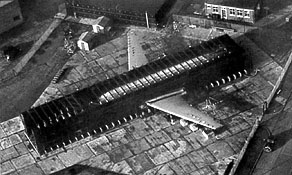Accident Inquiry
In 1949, the Air Registration Board required aircraft cabins to withstand twice maximum operating pressure as a margin for fatigue, or 2P, and to be tested to 1.33P, without any permanent deformation. De Havilland comfortably exceeded this requirement by designing the Comet to 2.5P, and testing it to 2P, or 16.5 lb/sq.in. Working closely with the Royal Aircraft Establishment at Farnborough, Comet centre section and wings were subjected to loads in continual cycles throughout 1949-1951. Smaller components were tested in decompression chambers, and larger sections of fuselage were immersed in a specially-built water-tank. If a component ruptured in air, it would be blown to bits. Water acted as a damper, allowing the pressure to escape through the crack or tear, but keeping the rest of the structure in tact. This made root cause analysis much easier.
The idea that further testing of pressurised aircraft might be necessary came during an investigation for the RAF. In October 1952, the Ministry of Supply proposed specific fatigue testing, starting with a static test at 2P, then 1.33P, followed by continued dynamic testing to 1.25P for 10,000 cycles. This was also taken up by the ARB, who published revised civil requirements in June 1953, but raised the test to 15,000 cycles. In July 1953, de Havilland tested the forward section of a Comet fuselage to the new standard. In fact it took 18,000 cycles before any damage occurred. At that stage, there was still no reason to suspect a flaw in the fuselage.
After the tragedies at Elba and Naples, an investigation began at the RAE, lead by its director, Sir Arnold Hall. An entire Comet was tested in a water tank by continual cycles to 1.33P. After 3,060 cycles, the fuselage failed at the corner of the forward port cabin window. This was similar to G-ALYP, except that the crack on YP had started at the ADF windows at the top of the fuselage, and

In the inquiry that followed, the Rt. Hon. Lord Cohen concluded that the Comet fuselage had been flawed, but that de Havilland had been working at the very limit of scientific knowledge. They had shown exemplary diligence, and were exonerated from blame.
What was puzzling was why these flaws had not been discovered by de Havilland’s own tests, or after the new ARB schedule in 1953. Sir Arnold Hall suggested that by applying 2P pressure initially, components had been strengthened, effectively “fatigue proofing” them. The results were published openly in the de Havilland Gazette, and the company had discussions with British, American and other manufacturers and organisations, benefitting the entire industry, and in particular the next generation of aircraft.
A Comet Series 4 was announced with a complete structural redesign. It proved robust, but the 6 year window of opportunity had closed, and the Comet's size and configuration was not competitive with new airliners from America. It sold in small numbers, and enjoyed 22 years service with civilian airlines. The last scheduled flight of a Comet was with Dan Air in November 1980; the last flying Comet, XS235 “Canopus” was finally withdrawn from the RAF in 1997, after 34 years. The Comet 4 was also the basis for the HS.801 Nimrod, which patrolled Britain's coast from 1969-2010.
